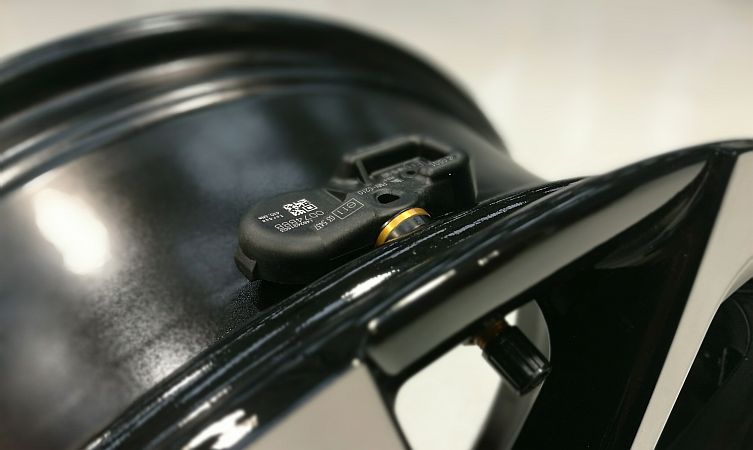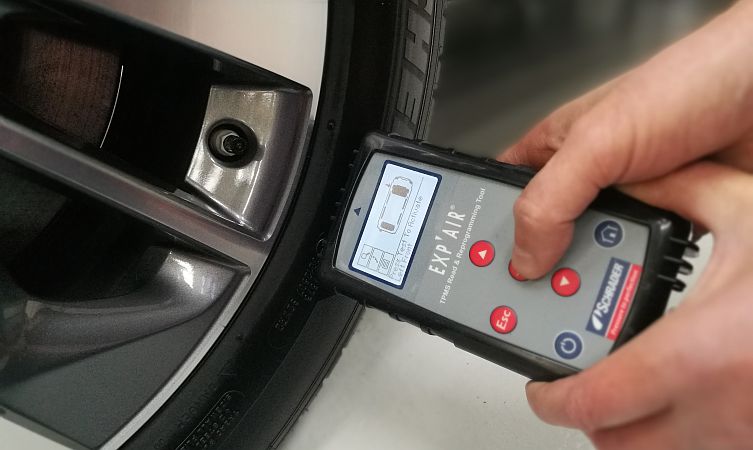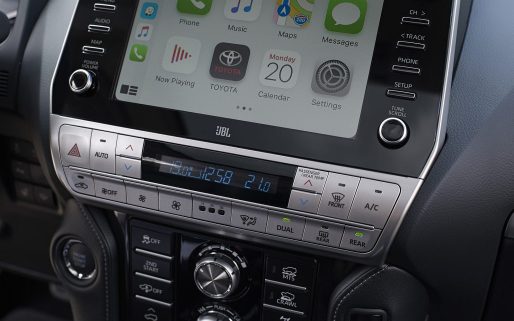Has a tyre pressure warning light appeared on your dashboard? The yellow symbol looks like the cross-section of a tyre with an exclamation mark inside. But what does the warning light mean, and what should you do about it?

What is the tyre pressure warning light?
The warning light is an alert message to the driver that there may be a loss of air pressure from one or more of the vehicle’s tyres. It comes from the Tyre Pressure Monitoring System (TPMS), an active safety technology that has become a legal requirement for all newly launched and factory updated passenger cars sold in Europe since November 2014.
Tyres represent the only contact your vehicle has with the ground, so maintaining the correct tyre pressure has many safety and efficiency benefits. These include:
- Prevents accidents caused by a critical decrease in tyre pressure
- Helps the vehicle perform predictably
- Saves fuel
- Reduces emissions
- Optimises tyre wear
How does a Tyre Pressure Monitoring System work?
There are two types of TPMS: direct and indirect. Direct systems are installed in the majority of Toyota’s current passenger car line-up, and this method uses a battery-powered sensor integrated into the valve assembly (see images below) to physically measure air pressure from within the tyre cavity itself.

Data from the sensor in each wheel is transmitted wirelessly to a control module connected to the car’s central computer, which prompts a visible alert for the driver if any of the tyres lose pressure. The control module is programmed with the unique serial numbers of the valves within the car’s system. This ensures that the TPMS assembly in each wheel only communicates with its host control module.

The only exception within Toyota’s passenger car line-up is the Proace Verso MPV. This model is equipped with an indirect system, which uses the existing wheel speed sensors within the anti-lock braking system to ‘measure’ tyre pressure by detecting differences in the rate of wheel rotation. A tyre with less air pressure will have a smaller circumference and therefore spin at a faster rate than a wheel that has not lost air pressure.
Data from the wheel speed sensors is communicated directly to the ABS control unit, which prompts a visible alert for the driver if any wheel speed abnormalities are detected.
What should I do if the tyre pressure warning light comes on?
If the tyre pressure warning light comes on, the air pressure in at least one of your tyres will have dropped below a minimum tolerance level – often a deflation of around 20-25%. This may indicate a leak, puncture, or some other kind of damage.
Dramatic changes in ambient temperature, such as driving from a snow-capped mountain to a warm and sheltered valley, can occasionally cause direct systems to prompt an alert until the temperature has stabilised. Similarly, indirect systems can occasionally mistake uneven tyre wear for a fluctuation in tyre pressure.
Irrespective of the circumstances, if the TPMS warning light comes on you should pull into a safe area and visually check the tyres. If any appear to be deflated yet undamaged you should try to re-inflate them to the correct pressure and reset the TPMS (see subheading below).
If the tyre has sustained more serious damage, it will be necessary to either continue your journey on the spare wheel, carry out a temporary repair using a tyre repair kit, or call an emergency breakdown service for a lift to a tyre centre.

How do I turn off the tyre pressure warning light?
Use the box below to identify the type of TPMS fitted to your car (only current models are listed below). You will also need to know whether the reset function is accessed via a button or sub-menu within the main display.
Once you have accessed the right sub-menu, instructions for resetting the TPMS will be shown within the main display. For those with a physical button, you simply need to turn the ignition on, then press and hold the TPMS button. The warning light will flash a couple of times and then extinguish, at which point the system has been reset.
| MODEL | TPMS TYPE | RESET ACCESS | LOCATION |
| Aygo X | Direct | Software menu | Vehicle Settings menu on Multi-info Display |
| Yaris | Direct | Software menu | Vehicle Settings menu on Multi-info Display |
| Yaris Cross | Direct | Software menu | Vehicle Settings menu on Multi-info Display |
| Corolla | Direct | Software menu | Vehicle Settings menu on Multi-info Display |
| Toyota C-HR | Direct | Software menu | Vehicle Settings menu on Multi-info Display |
| bZ4X | Direct | Software menu | Vehicle Settings menu on Multi-info Display |
| RAV4 | Direct | Software menu | Vehicle Settings menu on Multi-info Display |
| RAV4 Plug-in | Direct | Software menu | Vehicle Settings menu on Multi-info Display |
| GR86 | Direct | Button | Lower dashboard on passenger’s side |
| GR Supra | Direct | Software menu | Vehicle Status menu on Supra Command |
| Land Cruiser | Direct | Button | Under dashboard on driver’s side |
| Highlander | Direct | Software menu | Vehicle Settings menu on Multi-info Display |
| Proace Verso | Indirect | Software menu | Driving Functions menu on Pro-Touch display |
| Mirai | Direct | Software menu | Vehicle Settings menu on Multi-info Display |
What should happen if I replace any tyres?
Direct: The condition and function of the TPMS valve and sensor assembly should be checked each time the tyres are replaced. This will involve a physical inspection and electronic diagnosis using a proprietary technology (example device in image below).

The integrated battery has a life expectancy of around ten years and cannot be replaced. Electronic diagnosis should reveal the health of the battery, which will help you decide whether to replace the entire unit at the same time as the tyre.
Although the main valve assembly is robust, parts exposed to the atmosphere can deteriorate over time. So if the battery level is adequate and the main unit is being retained, it would still be wise to have the grommets, washers, collars and cores (see image below) replaced as a matter of course.

Indirect: As this system is not directly related to the tyres, no further measures are needed, assuming the tyres are being replaced on a like-for-like basis. However, it is always wise to replace the valves when changing tyres.
Will changing the wheels affect the TPMS?
Not if your car features indirect TPMS measuring. In which case, you can switch to and from winter tyres with no additional system programming.
Due to the accuracy and complexity of direct measuring, the TPMS control module is designed to recognise and communicate with only one set of wheels at a time. So if you regularly switch to and from winter wheels it will be necessary for a qualified technician to reprogramme the control module through the vehicle’s OBD port.

There are occasions when it may be necessary to drive on a wheel that is not equipped with a TPMS valve, such as after a puncture when the spare wheel is fitted. Under such circumstances, the warning light will remain illuminated. The vehicle or tyre monitoring system will not be damaged but the vehicle cannot pass its annual MoT test if the warning light is on.
Do I still have to check my tyres manually?
Although TPMS is designed to deliver a safety alert in the event of a significant loss of tyre pressure, it does not replace manual inspections. Each tyre should be regularly checked to see if it is inflated to the correct air pressure and has sufficient tread depth.







I recently purchased a new aygo 2019 x play what’s the easiest way to pump tyres I tried doing so but with the plastic hub caps I can hardly get to the valve please tell me the easiest solution
Ken Hamer
Hi Ken,
Thanks for your comment.
When inflating your tyres, you should firstly remove the valve cap from the valve of the tyre.
You should then connect the air hose from your chosen inflation method to the valve and start it so that air flows into the tyre.
When finished, disconnect the air hose and replace the valve cap.
If you are experiencing issues with this, you can contact your nearest Toyota centre for further help.
You can find your nearest dealer, here: https://www.toyota.co.uk/forms-v2/forms?tab=pane-dealer
Thanks.
i have a 2012 Toyota Yaris hatchback and cannot find the recommended tyre pressure anywhere what psi should the tyres be
Hi Kendall,
Thanks for getting in touch.
We would recommend contacting the Toyota distributor in your region for further help with your query.
Thanks.
My wife’s Toyota Aygo 2014 has just had the TPMS light come on along with the engine light and the slip indicator light. All the tyres are nearly new and the correct pressure. I have tried pressing the reset button in the glove box without success. How do I know if this is a direct or indirect system, with regard to having the sensors replaced.
Hi Dave,
Thanks for your comment. We’re sorry to hear about the issue you’re experiencing with your Aygo.
We would recommend taking the vehicle to your nearest Toyota centre in order for them to assess the vehicle and determine the cause of the issue with a view to fixing it.
You can find your nearest centre, here: https://www.toyota.co.uk/forms-v2/forms?tab=pane-dealer
Thanks.
I have toyota avensis estate 2015 my 2 tmps are broken. 2 are working i have light on dash. What is solution please help.
Thanks
Hi Majid,
Thanks for getting in touch with us.
We would recommend taking your vehicle to your nearest Toyota centre, who will be able to assess the car and make any necessary recommendations.
You can find your nearest centre, here: https://www.toyota.co.uk/forms-v2/forms?tab=pane-dealer
Thanks.
Hi.
I purchased a brand new Toyota Yairs on 1st September 2020. Please can you advise on the following.
My TPMS light illuminates on the dash board after about 10/20 miles of travelling on every journey and stays on for anything up to 30 miles, when it goes off by itself. I have checked the presures and they correspond with the manual. I have taken back to the dealer whom I purchased it from, they are unable to find any fault and inflated the tyres to slighl;y above the ones recommeded in the manual. Each time the tyres have been inflated the rest button has been used to reset.
Sadly the probelm has occured again, this has been an ongoing problem since the day after I purchased the vehicle in September so temperature can’t be the issue.
The dealer has been helpful but are unable to reticify the fault. I see from the other coments placed by other owners, this is not a one off problem.
Please could you advise the way forward please., Thank you
Hi Jeremy,
Thanks for your comment. We’re sorry to hear this.
For issues such as this, we would always recommend contacting your nearest Toyota centre for further help.
However, if they are unable to do anything more, your next step would be to contact our Customer Relations team, who are best placed to offer any necessary advice.
They can be contacted here: https://www.toyota.co.uk/help-centre/email-us
Thanks.
Greetings,
TPMS lamp of my Toyota corolla e180 is on. All pressures are normal. My vehicle is 2016 model. Could one of my Tpms sensors have run out of battery?
Hi Erdem,
Thanks for getting in touch.
For further help with your inquiry, we would recommend contacting Toyota in your region as we can only advise on UK specification vehicles.
Thanks.
Hi
I’ve got a rav4 2014 version. I need a TPMV for it but on the Toyota site on eBay, it suggests the valve is 2018. Will that still work?
Hi Davie, thanks for your comment.
We would recommend checking for the exact part number. You can do this by giving the parts department of your local Toyota Centre a call, or we can check with out parts team once they are back in the office. If you choose the latter, we will need your VIN and registration number.
Thanks
hi
is this the right product number for my Rav4 reg EJ69UGO ?
Genuine Toyota Rav4 Tyre Pressure Sensor TPMS Valve 42607F4020
Thanks
Hi Dave,
Thanks for getting in touch with us.
We’ve checked with our wider team, and the part number for your RAV4’s TPMS valve is 42607-60010.
Thanks.
Very useful article. I have just had my 2017 GT86 TPMS reprogrammed at the local dealer (charged £63).
I am told the problem is the result of using a second set of Toyota wheels on trackdays and the original sensors being ‘out of range’, even though the trackday wheels have no sensors at all. I specifically asked if this would happen every time the original wheels with sensors are separated from the car and was told it probably would.
I also asked about the spare wheel scenario and was told it might depend on how long the wheel needing puncture repair was separated from the car.
As the dealer advice is rather vague I wonder if you could tell me where else I can get a clearer answer to these questions:
If the car is separated from the wheels with sensors for a 24 hour trackday and the trackday wheels have no sensors, will the TPMS always need reprogramming when the road wheels are refitted?
If a wheel is removed for puncture repair how long can it be separated from the car without needing reprogramming?
Hi Mark,
Thanks for contacting us.
In order for us to look into this for you, could you please provide us with your UK reg?
Thanks.
Hi, thanks for the quick response. My registration is YT17 RRV a white GT86 Pro.
Mark
Hi Mark,
Thanks for providing these details.
We’ve checked with our technical team and, providing the original wheels go back to the same location and then the initialisation process in the Owner’s Manual is performed using the switch, then the system should function correctly unless there is a fault somewhere.
Thanks.